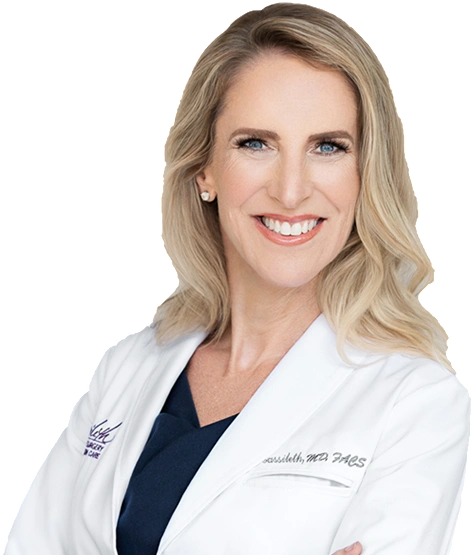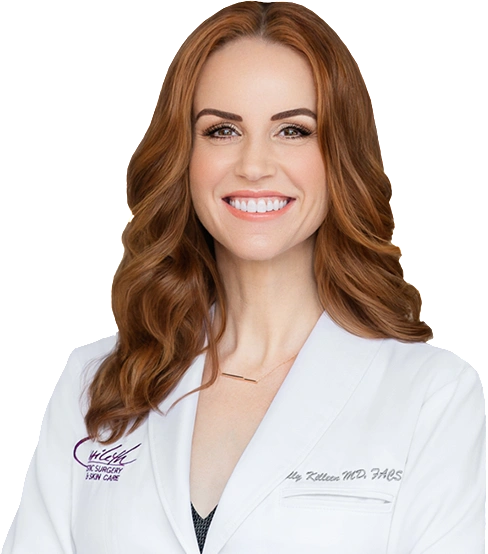
Capsular Contracture Treatment
Capsular Contracture Treatment & Repair in Los Angeles, CA
Capsular contracture is a relatively common condition that sometimes occurs after breast augmentation. Capsular contracture can cause breasts to raise, to become distorted, and can make them painful and hard to the touch.
A capsule is the normal scar tissue that the body’s immune system produces to surround a breast implant. This capsule of scar tissue is usually pretty thin, sometimes almost transparent. The capsule should be larger than the implant, allowing the implant to move around inside the capsule pocket. But in capsular contracture, the capsule becomes thicker, and gets tighter, which makes the space for the implant smaller and smaller. As the capsule tightens, the implant rises to a higher position on the chest, making the breast look tight and artificially round, like a baseball. The capsule can get so small that the implant feels quite firm (Baker grade iii capsular contracture). It can even feel hard and be painful (baker grade iv capsular contracture).
Browse our photo gallery to see the real-life difference our capsular contracture treatment can make.
Capsular contracture is caused by anything that leads to inflammation of the capsule, which causes the capsule to thicken and tighten. This complication can occur with saline implants or silicone implants. The cause of capsular contracture varies from patient to patient, and more than one cause may be present in one person. Common reasons include trauma or hematoma (bleeding) around the implant from the initial breast augmentation surgery, bacterial infection and biofilms (a film of cells that grow on inert surfaces), ruptured silicone or remnants of silicone from an old rupture, or patient reactivity to a foreign body. We are finding that biofilms are more frequently the cause of contracture than initially thought, with as many as half of all contractures associated with biofilms.
Imagine the capsule as a net that contracts and tightens. If the inflammation doesn’t go away, or gets worse over time, the net gets tighter and tighter. Eventually, the net shrinks to the same size as the implant, trapping the implant so that it can no longer move within the net, and it becomes hard and immobile.
Board-Certified Beverly Hills Plastic Surgeon, Breast Specialist, and Direct-to-Implant Breast Reconstruction Inventor
How we obtain our 95% + cure rate:
During the capsular contracture surgery, we carefully remove the complete capsule. This can happen with the entire implant still inside the capsule, called “en bloc” capsulectomy, or the capsule can be removed after the implant, called “complete capsulectomy.” Partial removal of the capsule, sometimes called capsulotomy, is not sufficient to cure capsular contracture.
After the capsule is removed, it is biopsied and sent to a pathology lab to test for biofilms, which are low-grade bacteria that live on the surface of the implant and can cause contracture. We then look for any adjacent silicone leakage or other abnormalities in the surrounding breast tissue. All abnormal breast tissue must be removed, but all normal surrounding tissue should be preserved. Next, we use an antibiotic power-wash to combat potential sources of infection, including biofilms. Finally, an anti-bacterial solution is left within the breast, to complete the eradication process.
In your initial consultation, we will determine your likelihood for carrying a biofilm. Biofilms are much more likely to be present in patients with capsular contracture.1 Likely biofilm carriers are: unilateral contracture patients (only one side affected); patients who had contracture following breastfeeding; patients with a low-grade infection following their initial augmentation; and patients who have contracture following dental cleaning or illness. Biofilm carriers may be more likely to have Bii (Breast implant illness).
Double-Board-Certified Beverly Hills Plastic Surgeon and Breast & Body Specialist
Once the implant and capsule have been removed, our doctors create an internal bra with acellular dermal matrix (ADM), a biomaterial sheeting, which resists contracture and provides a protective layer between the breast and the implant. The ADM allows the body’s natural reaction to occur: a healthy capsule can form around a new implant and fuse with the ADM, keeping the pocket soft and pliable. It also supports the implants and keeps your breasts in the ideal shape and position. The presence of the ADM further decreases the recurrence rate.
After your procedure, you will be kept on antibiotics until the biopsy test results are received from the lab. If bacterial growth is detected, we will send you for a consult with an Infectious Disease specialist. You will begin a course of antibiotics tailored to the results of your microbiology tests. If your results are negative (no infection), you will undergo a shorter course of prophylactic antibiotics. Patients at high risk of biofilm, those with unilateral contracture, for example, are often kept on a one-month course of antibiotics as it is common to receive positive test results for biofilms two and even three weeks after the surgery.
Our care rate is over 95%, thanks to our thorough approach to treating all aspects of contracture. There is a one-week recovery period, followed by a full month of restricted exercising after surgery. After one month, we allow you to resume all activities. We ask that you avoid underwire bras for around three to six months after surgery, in order to allow the breasts to relax into the proper position.
Capsular contracture is one of the most common complications following breast augmentation, ranging from 2.8% to 20.4% 2 or roughly one in six breast augmentation patients.3
No, capsular contracture is not typically dangerous but can cause unsightly surface abnormalities on the breast due to contracting scar tissue squeezing the breast implant. Capsular contracture can pose health risks when the capsule is so tight that it ruptures the breast implant.4
In extreme cases, capsular contracture can cause pain in the breasts. We use the Baker scale to rate the severity of capsular contracture. Grades I-III look and feel normal but grades II and III may feel firmer than a normal breast implant. Grade IV is the most likely to cause pain from constriction and the breast may appear unnatural in shape.
Patients cannot take preventative measures to avoid capsular contracture however there are some surgical techniques that result in less instances of developing the condition. For example, implants with subglandular placement are associated with higher instances of capsule contracture.5
Yes. Capsular contracture can only be cured if your entire capsule is removed. Since the capsule encapsulates the entire implant, the implant is removed with the capsule. Once the capsule is removed from the implant the implant can be replaced back into the breast pocket, but in general we prefer to place brand new implants.
Traditional methods of correcting capsular contracture often result in recurrence, but our surgeons have created revision surgery techniques to solve capsular contracture, resulting in a cure rate of over 95%.
1 Ajdic D, Zoghbi Y, Gerth D, et al., The Relationship of Bacterial Biofilms and Capsular Contracture in Breast Implants. Aesthet Surg J. 2016: 36(3): 297–309
2 Headon H, Kasem A, Mokbel K. Capsular Contracture after Breast Augmentation: An Update for Clinical Practice. Arch Plast Surg. 2015;42(5):532-543. doi:10.5999/aps.2015.42.5.532
3 ASPS. What is capsular contracture and how can it be treated? Available: https://www.plasticsurgery.org/news/blog/what-is-capsular-contracture-and-how-can-it-be-treated. Accessed October 27, 2021.
4 ASPS. What is capsular contracture and how can it be treated? Available: https://www.plasticsurgery.org/news/blog/what-is-capsular-contracture-and-how-can-it-be-treated. Accessed October 27, 2021.
5 Archives of Plastic Surgery. Capsular Contracture after Breast Augmentation: An Update for Clinical Practice. Available: https://www.ncbi.nlm.nih.gov/pmc/articles/PMC4579163/. Accessed October 27, 2021.
Contact Cassileth Plastic Surgery about capsular contracture in Los Angeles, Beverly Hills, Santa Monica, and beyond.

Dr. Kelly Killeen is not just an outstanding surgeon and artist, she is also an angel. I had 15+ surgeries to correct an ongoing problem for last 10 years, numerous super-famous doctors worked on me, in different parts of the world, including Geneva, Berlin, etc.. So by the time I got into Dr. Kelly's hands the words "total mess" don't even begin to describe the actual condition of what used to be my breasts. Dr. Killeen, just as regular angel performed a miracle and made everything good again. I love you. There is also nurse Dee who is just incredible human being, here level of compassion, love and care is truly rare. Last but not the list there is a Brit called Jade - she is so beautiful, funny and totally awesome, I will find a reason to come again for some facial peeling or something else simple just to see you guys! I am so blessed to have met these beautiful people, they maybe just part of exceptional medical team, but in my heart they will always be my friends...
Arrange a consultation for capsular contracture treatment at Beverly Hills' Cassileth Plastic Surgery. Women from Santa Monica, the entire Los Angeles area, and beyond can Send a message online or call (310) -278-8200.
Connect with us on social media! We pride ourselves on building real relationships with our patients near and far.

